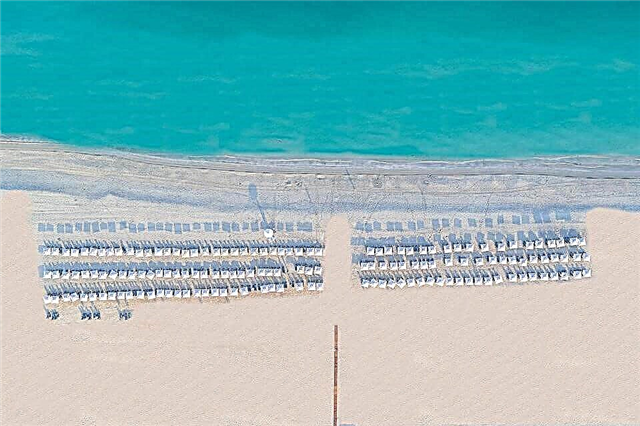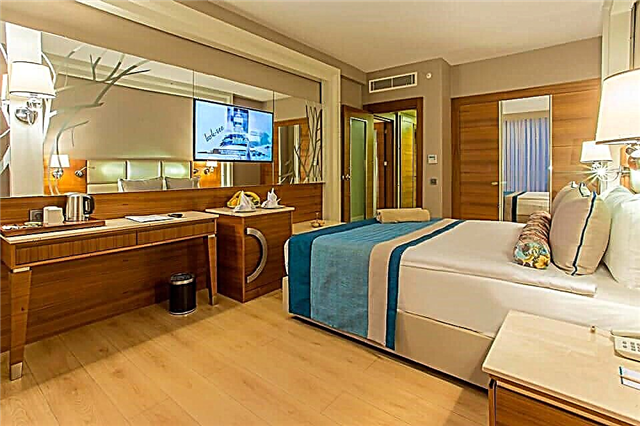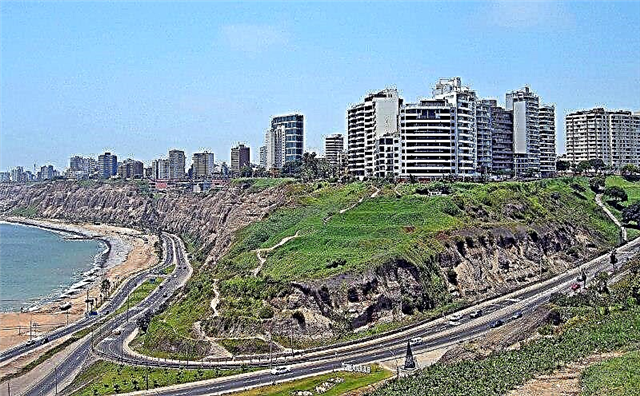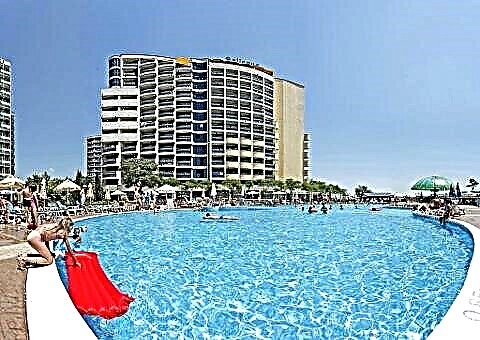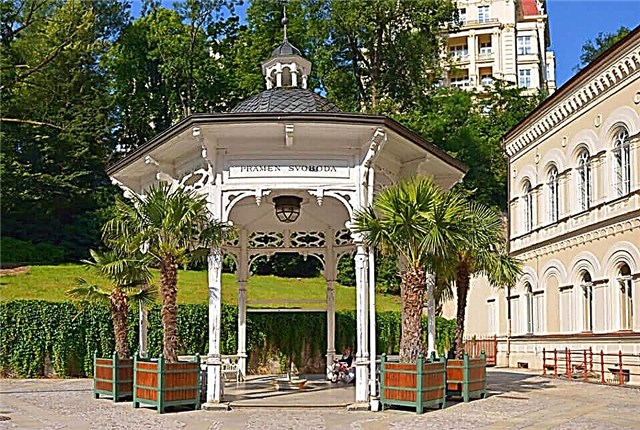An old legend says that the Czech king Karl loved to hunt in these places. One day he wounded a deer, which, gathering all his strength, jumped off a cliff into a hot spring. The animal instantly got rid of its wounds and fled. Another legend claims that the king himself accidentally stepped with his injured foot into an amazing stream of hot water. Karl was surprised to see that his leg no longer hurt. He ordered the construction of a hunting lodge near the stream. This event served as the foundation of the city, which was named after the famous king. The second part of the name - Vary - says that the water in the springs is hot, and people at first literally "boiled" in it. Only in 1522, a doctor named Payen suggested not only taking baths, but also drinking medicinal water. Over time, the colonnades and springs of Karlovy Vary gained popularity among wealthy and famous people. Representatives of royal and royal families, many aristocrats, were treated there. In Russia, the city gained fame after Peter I came to these places twice.
Mill colonnade

On this place in 1792-1973 a wooden building was erected for the first time in Karlovy Vary. Visitors could take shelter here from bad weather and perform the exercise necessary after taking medicinal water. That is why the popularity of the keys under the structure has increased dramatically. A few years later, in 1811, the Dresden architect Gisel built a new promenade in the Empire style, and in 1811 it was replaced by a stone colonnade created in the pseudo-Renaissance style. The author of the project was the architect who changed the face of the city - Josef Zítek.
At the beginning of June 1811, it was solemnly opened to visitors. Twenty years later, part of Bernard's Rock was demolished and the northern pavilion was erected on this site. This is the largest colonnade, which contains five springs - Mill, Rusalka, Prince Wenceslas, Libuše and Skalny. The attic is decorated with sandstone sculptures. These are symbolic images of months. Alfred Schreiber and Karl Wilfert worked on the sculptures. The orchestral shell serves as a striking accent, which is overshadowed by the bas-relief by Vaclav Lokvenets.
Garden colonnade

Once there was a concert restaurant built in 1880-1881. It was created from cast iron elements that were cast at the Blanenskiy metallurgical plant. The structure was built according to the project of architects Fellner and Helmer by the builder Waldert. The complex was inaugurated in early June 1881. Over time, the pavilion fell into disrepair, and it, along with part of the veranda, was demolished in 1965.
Until our time, only the eastern part has survived, which is called the Garden Colonnade. This graceful building was reconstructed in the years 200-2002. On the one hand, the Serpentine Spring was brought into it, and on the other, a transition was made to the Garden Spring, which is located in the basement of the Military Sanatorium.
Karlovy Vary is recommended for visiting people suffering from diseases of the gastrointestinal tract. Doctors create an individual schedule for each patient according to which medicinal water should be taken. It should be consumed fresh and at exactly the temperature that the water has when it comes to the surface. To comply with these conditions, special mugs are sold in the city, a characteristic feature of which is a narrow neck, thus the water temperature remains longer. They say that water poured into a bottle loses some of its healing properties after a while.
Market colonnade

Here, in the heart of the city, there was once an old bathhouse. After the healing waters helped Charles IV to heal, the place gained popularity. A small gazebo and a promenade veranda were built over the springs. In 1883, an elegant carved promenade in the Swiss style was built on the site of the town hall. At the beginning of the 20th century, it was brought to the Market Spring. Now visitors can use water from three springs at once - Market, Lower Castle and Charles IV spring. The openwork structure is one of the main attractions of the city.
Drinking mineral water is recommended under medical supervision. Of course, a tourist who has come to the city for a few days and tried a little from each source will not harm his health. But if you mindlessly use mineral water for 2-3 weeks, either from one spring, then from another, you can worsen your well-being. It should be remembered that not only the temperature differs, but also the composition of the water, and all elements have their effect on the body. Therefore, a prerequisite for treatment is the consultation of a doctor - a specialist in balneology.
Castle colonnade

In 1769, for the first time, they were able to catch the famous Castle Spring. The renowned doctor Becher has proven the healing properties of water. A gazebo was built over the key in 1797, and in 1830 it was replaced by a promenade designed by Joseph Esch. A new colonnade was built 80 years later. Its author was the architect Johann Friedrich Oman. It was supposed to connect the Castle Spring and the Market Colonnade, turning them into a single space. This building was decorated with a bas-relief in the Art Nouveau style.
Over time, the building fell into disrepair, and in 2000 it was rebuilt. On this place, a complex health resort "Castle Lazni" was erected. The project was created by the architect Mikolash. The visit is available only to the clients of the establishment. Spa facilities include the Lower and Upper Castle Springs.
Lower castle spring

In the historic center of the city, on the left bank of the Tepla River, the lower Castle Spring is open for free visits. The water temperature there is 55.6 degrees, the flow rate is 2.5 liters per minute. Carbon dioxide saturation - 600 mg / l. It was first captured in 1769. In 1784, a very cold winter stood out and the townspeople were left without water. It was from there that she was brought to public fountains.
At the same time, the doctor David Becher, after analyzing the water, found that the composition was the same as in the Geyser. The first gazebo was erected in 1797, but 12 years later the spring went underground. It only appeared on the surface again in 1823. The first colonnade was built there in 1830, and 80 years later it was rebuilt in the Art Nouveau style. In this form, it existed for about 100 years, later it was converted into the Castle Spa, and the source was taken out to the Market Colonnade.
Upper Castle Spring

The water has the same origin as in the Lower Castle Spring, just the stream is divided into two parts and fed into two different vases. But there are also some differences. The upper spring is located higher above sea level, therefore it differs in temperature (49.8 degrees). And also contains a little more carbon dioxide - 763 mg / l. It is overshadowed by a magnificent pavilion built in the Art Nouveau style. The water content is rather weak - only 1.5 liters per minute. The spring is usually covered with glass, and only the clients of the Castle Spa have access to it.
Serpentine source

It can be found in the resort area of the city, in the Garden Colonnade. It was brought out recently, in 2001, this is the most recent source. It gives 1.8 liters per minute, the water temperature is 30 degrees. Carbon dioxide is 1.6 g / l. The source received such an original name thanks to the snakes, which were found in large numbers near the colonnades. This is reflected in the design - a low column is decorated with the image of a snake, from the head of which water flows. This structure is crowned with a decorative vase, the handles of which are made in the form of snakes. You can get there on foot in just 15 minutes, if you walk from the Geyser.
Mill source

The inhabitants of the city knew about him back in the 16th century. It got its name from the mill, which operated on the Tepla River until the end of the 18th century.The healing properties of water have been known for a long time, and already in 1705, doctors prescribed it to their patients for treatment. Its popularity was so wide that they even erected a special Baroque Mill Hospital. This happened in 1711. The water was not only drunk, but also used for healing baths.
In 1827, the Mill Embankment was improved. The area has changed beyond recognition. The colonnade of the New Spring was completed, the hospital was demolished. A beautiful new pavilion was erected in its place. But he did not last long either. The project of the architect Zytek provided for the construction of the Mill Colonnade, which still pleases the eyes of residents and guests of the city.
The water produced here was so popular all over the world for its medicinal properties that it was even bottled and exported to other countries. Its temperature is 56.6 degrees, the water content is 4.5 liters per minute, the saturation with carbon dioxide is 0.6 g / l. The distance from the Geyser is half a kilometer, the road will take about 10 minutes on foot.
Dorotk's spring

In the southern part of the city, on a slope overlooking the right bank of Tepla, the Dorotka spring, discovered in the 18th century, comes to the surface. A pavilion was erected above it. It has not been available to visitors since 2012, it is used for observation purposes only. This is one of the stations that is designed to track the amount of carbon dioxide in water.
In one minute, Dorotka gives out only half a liter of water and 45 liters of gas. A small trickle of low-mineralized water flows into Tepla near the Charles IV bridge. Previously, he was taken to Dorothea's Empire style gazebo, and only then he was brought to a small stone pavilion. From the city center you can walk to it in half an hour.
The spring of Charles IV

Back in the Middle Ages, healing water came to the surface of the earth near the Market Square. In those days, this spring was called Glutton (Zhrout). There is an old legend, which says that it was there that Emperor Charles IV healed his legs, affected by the disease. This event was immortalized by the blacksmith Adolf Zerkel in the bas-relief "The Discovery of the Hot Springs by Charles IV". In 1883, a Swiss-style wooden colonnade was built over the water outlet. Its authors were the architects from Vienna Fellner and Helmer.
The water is hot enough there - 64 degrees. 4.8 liters per minute comes out. It is rich in carbon dioxide - 250-450 mg / l. Located in the historic center of the city. The road from the Geyser will take only five minutes on foot.
Prince Wenceslas Spring

For the first time he showed himself to people in 1784, when he made his way out from under Bernard's rock, with which his first name was associated. Then a powerful fountain of water rose 4 meters. It was from here that water was extracted, from which the famous mineral salts were then produced. In 1870, the architect Zítek proposed the design of the colonnade, which was later built over it.
The stream of water was divided into two parts and led out into different vases. In one of them, the flow rate is 4 liters per minute, the temperature is 65.6 degrees. The second gives off water half as much, the temperature is -64.3 degrees. One liter contains 0.5 grams of carbon dioxide. It is located in the resort area of the city, half a kilometer from the Geyser.
Libuche Spring

When a new mill colonnade was being built, designed by architect Zytek, another water outlet was discovered. Four small springs merged into one stream and made their way out in the place of the orchestra shell. At first it was named "The Source of Elizabeth's Roses." Only in the middle of the 20th century, in 1947, it got its modern name. Its favorable location in the largest colonnade has brought fame to everyone who comes to the resort. Its water content is from 3 to 5 liters per minute, the temperature is 62 degrees. One liter contains 0.55 grams of carbon dioxide.
Mermaid Spring

It was known as early as the 16th century, but its popularity especially grew in the middle of the 18th century, at the same time the name "New Source" took root. It was located next to the Mill Hospital and was originally located under a simple wooden canopy. Later, at the end of the 18th century, a place for walking was built after taking the healing water. Even bad weather now could not interfere with the healing process. There was also an appointment with doctors who prescribed treatment with water to patients.
At the beginning of the 19th century, this part of the resort was the most popular. In 1811, the old building was demolished, and a new colonnade was built over the outlet of the water to the surface, which stood for 60 years. Subsequently, a stone promenade was erected in its place. The water here has a temperature of 60.2 degrees, from 4 to 7 liters flow out per minute, one liter contains 600 mg of carbon dioxide. The road from the Geyser takes about 10 minutes.
Stepanck's Spring

On the southern outskirts of the city is the Richmond Hotel. In the park in front of it, you can find a cozy octahedral wooden gazebo by Alois Klein, into which the fourteenth mineral spring is led. It was known back in the 18th century, but it was only possible to catch it in 1884. This spring was named in honor of Stephanie, the Austrian archduchess. The water was immediately recognized as healing due to its ferrous composition and acidic properties. But people could not use this opportunity for long. The source went underground at the beginning of the 20th century. They were looking for him for almost a hundred years and were able to catch him again only in 1997. At the same time, a beautiful gazebo in the Swiss style was erected.
You can draw 2.5 liters of cool water per minute (the temperature is only 13 degrees). It contains more than 1.2 grams of carbon dioxide per liter. Water in this vein is rich in iron ions, therefore it is popular with patients diagnosed with anemia. It is one and a half kilometers away from the Geyser, which is a half hour of a pleasant walk through the old resort town. Stepanka is still not registered as a natural healing resource.
Source Freedom

This is a relatively new outlet for water to the surface. It was discovered in the sixties of the 19th century. At that time, the spa Lazne III was under construction, and when the foundation was laid, a trickle of water emerged. The source was taken out between two hospitals - New and St. Bernard's hospital, which was located under the rock of the same name. Previously, there was also a Hospital Spring, which later went underground. In 1865, a beautiful decorative pavilion was erected.
The octagonal wooden structure blends harmoniously with the landscape. The name changed several times - at first it was the Spa Spring, then it was named in honor of Emperor Franz Josef I, and in 1946 it received the name "Svoboda". You can find it by walking 600 meters from the Hot Spring to Spa III. It gives 5 liters of hot water per minute (temperature 62.4 degrees). The carbon dioxide content is 0.55 g / l.
Garden spring

In 1852, a military sanatorium was founded in Karlovy Vary. During the construction of the foundation, a water outlet was discovered. The source was originally named Imperial. His water was used for the patients of the sanatorium. The water flow is divided in two - one part is led out into the hall, the other into the basement. From 6 am to 6.30 pm, guests of the city can taste this water, which has an unobtrusive sour taste. To get to it, you need to walk from the Hot Spring towards the Garden Colonnade, located in the Dvořák gardens, about 800 meters, this is a 15-minute leisurely walk. The water has a temperature of almost 42 degrees, you can draw 1.5 liters per minute. One liter contains 0.75 grams of carbon dioxide.
Rock spring

There used to be a rather damp and muddy place under Bernard's Rock. Horses were taken there to bathe, and the people called it the Horse Hospital. A thin stream of water made its way to the surface of the earth next to the Teplaya River. This was the future Rock Spring. They caught it in 1845, then part of the rock was broken off. The wooden shed, built without architectural design, protected visitors from bad weather.
In 1892, the famous Mill Colonnade was completed according to the project of the talented architect Zitek, and the Rock Spring received a new beautiful pavilion. Water is discharged there from a 30-meter depth, passing through several wells. It has a pleasant temperature (48 degrees), the water content is 2.2 liters per minute. One liter contains 0.65 g of carbon dioxide. You can find it by walking half a kilometer from the Hot Spring, under Bernard's Rock, which is located at the very end of the Mill Colonnade.
Market source

In 1838, construction work was carried out in the center of the city - on the Market Square. During the work, another outlet of water to the surface was discovered. From the very beginning, the source had an unstable character, it disappeared, then it appeared. It was necessary to drill more than one rather deep well before it was possible to make the water flow constant. The water was then taken to the Marktbrunn house, on the first floor. Even then, there were several such spa houses next to the square.
The building was demolished in 1904, and in its place was erected the wooden Market Colonnade, which was built in the Swiss style, like many other buildings in Karlovy Vary. Of particular interest is the place where the water flows. It is a semicircular apse with amazing acoustics. Concerts are often held here. The distance from the Geyser is only 200 meters. Water has a temperature of 62 degrees, almost 5 liters per minute are drawn. It contains 0.5 g / l of carbon dioxide.
This resort was made famous by the famous Dr. Becher. He developed a method for extracting salt, which became very popular as a laxative. Also his name is the famous herbal tincture - "Becherovka". The sale of mineral salt and famous visitors to the resort played a role in the development of the city and it began to grow rapidly. Unfortunately, during this period, a huge part of the city was destroyed by fire. For example, only one tower remained from the royal castle. Most of the buildings were rebuilt as they could not be restored.
Karlovy Vary survived the heyday in the 19th century, even the Napoleonic wars that thundered throughout Europe did not prevent this. Every day on the embankments one could see noble patients strolling from one key to another. Many grand dukes and heads of state came here incognito. After the end of World War II, the resort town was nationalized and began to develop rapidly. It is separated from Prague by only 118 km, it is not difficult to get to the city. You can go there with a guided tour. This is the most comfortable way, including the services of a guide. Another option is that special yellow buses leave from Florenc train station in Prague every hour. The journey will take two hours.
The most famous attraction is the hot thermal springs. It is easy to find them, almost all of them are located one after the other. The higher the water temperature, the greater the amount of mineral salts dissolved in the water, but the amount of carbon dioxide in this case is small. Conversely, in cool springs, there is more carbon dioxide, and the mineralization is weaker.
The most popular spring, the Geyser, can be called the symbol of the resort. Water erupts from a great depth - two kilometers. The height of the fountain is up to 12 meters. The water in it is very hot and reaches a temperature of 72-73 degrees. In the 70s of the XX century, colonnades and awnings were built around it. The geyser is able to provide all the health centers of the city with mineral water.
The entrance to the pavilion is free, it is open from 9 am to 7 pm. The water is cooled down to three different temperatures and supplied to several pump rooms. There you can also visit an interesting excursion "The Geyser Underground". Tourists are shown underground keys and petrification, thanks to which unique jewelry and various souvenirs are made. You can go on excursions from late spring to early autumn on any day. Tickets are sold in the lobby.
The least visited source by tourists is Zhelezisty. This is the coldest spring in the resort. The water temperature reaches no more than 12 degrees. The water is rich in iron and arsenic compounds. The amount of this element is small enough so that it does not harm health. Nevertheless, tourists rarely visit this spring. Baths are also very popular. They strengthen the immune system, have a beneficial effect on the joints, improve the functioning of the nervous system, and relax the muscles. This opportunity can be obtained both in hotels and in old hospitals.
In addition to health benefits, the resort offers visitors a large number of attractions, enchanting natural landscapes, an interesting and rich cultural life. Representatives of the European aristocracy still meet there (usually such meetings are held in April each year), and international festivals dedicated to ancient, modern and classical music are held. There are also film festivals. Concerts are often held.



